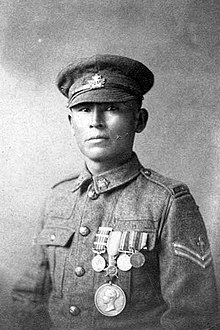Francis Pegahmagabow
Appearance

Francis Pegahmagabow, MM and two bars, (9 March 1891 – 5 August 1952) was the aboriginal soldier most highly decorated for bravery in Canadian military history and the most effective sniper of World War I. Later in life, he served as chief and a councilor for the Wasauksing First Nation, and as an activist and leader in several First Nations organizations.
| This article about a military figure is a stub. You can help out with Wikiquote by expanding it! |
Quotes
[edit]- When I was at Rossport, on Lake Superior, in 1914, some of us landed from our vessel to gather blueberries near an Ojibwa camp. An old Indian recognized me, and gave me a tiny medicine-bag to protect me, saying that I would shortly go into great danger. The bag was of skin, tightly bound with a leather thong. Sometimes it seemed to be as hard as rock, at other times it appeared to contain nothing. At night it seemed to be rising and falling like it could breathe. I kept it with me at all times and I don't think I could have survived the war without it. —Francis Pegahmagabow
- Carroll, Al (2008). Medicine bags and dog tags: American Indian veterans from colonial times to the second Iraq War (2008 ed.). University of Nebraska Press. ISBN 9780803210851. p. 111
- My mother [Eva] told me he used to go behind enemy lines, rub shoulders with the enemy forces and never get caught. … He was always saying how we have to live in harmony with all living things in this world.—Duncan Pegahmagabow (son).
- Veterans Affairs Canada (June 30, 2005). Native Soldiers - Foreign Battlefields. Veterans Affairs Canada. Retrieved on 2010-05-11.
- he [agent Daly] conducts his office as being a whole Dominion Government, Indian Agent, Indian Chief and Council, all into one … the Agent appears as taking too much advantage of his powers over the Chief and council and causing a considerable strife an [animosity] amoung the Indians of this Reserve … foiling the labors of the chief and members of the council, discrediting those who assist to maintain good government of the Band.
- Brownlie, Robin (2003). A fatherly eye: Indian agents, government power, and Aboriginal resistance in Ontario, 1918-1939 (2003 ed.). University of Toronto Press. ISBN 9780195417845., p. 153

